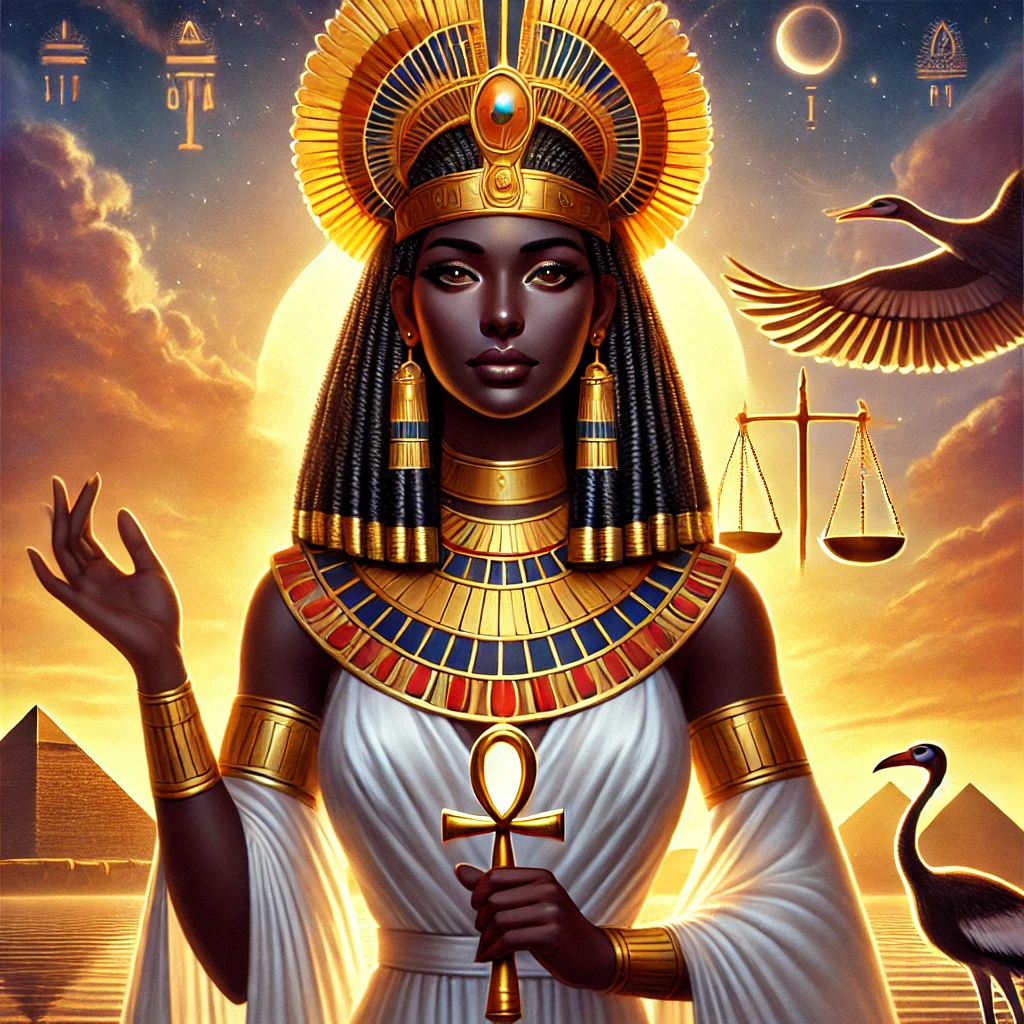
3. Ma’at
Timeline: Old Kingdom (c. 2686 BCE) onward.
Known For: Truth, justice, and cosmic order.
Role: Maintained universal balance and moral integrity.
Symbols: Ostrich feather, scales.
Cultural Significance: Foundation of law and governance.
Ma’at: The Goddess of Truth, Justice, and Cosmic Order
Ma’at is one of the most profound and revered goddesses of ancient Kemet, embodying the very
essence of truth, balance, and harmony. More than a deity, Ma’at represented a guiding principle of
universal order that governed both the cosmos and human society. Her influence was felt in every
aspect of Kemetic life, from the movements of celestial bodies to the moral conduct of individuals.
Ma’at was the foundation upon which laws were built and the glue that held the universe together.
The Story of Ma’at: Keeper of Balance
In the earliest days of creation, chaos—known as Isfet—threatened to consume all existence. It was
Ma’at who emerged as the force of order, bringing structure to the cosmos. The gods themselves
abided by her principles, for without Ma’at, the universe would descend into chaos once more.
Pharaohs ruled in her name, their duty being not only to enforce her laws but to live by her
example. A pharaoh’s legitimacy was measured by their ability to maintain Ma’at within their
kingdom, ensuring justice, fairness, and prosperity for their people.
In the afterlife, Ma’at played a pivotal role in determining a soul’s fate. The famous “Weighing of
the Heart” ceremony saw the deceased’s heart placed on one side of a scale and Ma’at’s sacred
ostrich feather on the other. A heart heavy with wrongdoing would tip the scale, condemning the
soul to be devoured by Ammit, the soul-eater. However, a heart balanced with Ma’at’s feather
symbolized a life of virtue, granting the soul passage into the eternal fields of bliss.
The Appearance of Ma’at: A Symbol of Grace and Balance
Ma’at is depicted as a serene and composed figure, exuding an aura of wisdom and tranquility. Her
features are deeply rooted in the African heritage of Kemet. She is shown with radiant deep brown
skin, symbolizing her connection to the fertile land of the Nile and the life it sustains. Her almond-
shaped eyes reflect clarity and insight, while her high cheekbones and full lips express dignity and
authority.
Her headdress is adorned with a single ostrich feather, the symbol of truth and balance. This feather,
central to her identity, embodies the lightness and purity of a life lived in harmony with cosmic
principles.
Ma’at’s attire is elegant yet understated, reflecting her role as the embodiment of law and justice.
She wears a simple sheath dress of pristine white linen, signifying purity and integrity. Gold accents
on her attire and jewelry symbolize her divine nature and her eternal connection to the gods. Around
her neck, she often wears a wide collar of turquoise and lapis lazuli, representing the heavens and
cosmic balance.
Her posture is upright and regal, holding either a scepter or the ankh—the symbol of life. She is
sometimes depicted seated on a throne, signifying her foundational role in governance and law.
The Weighing of the Heart: A Ritual of Justice
One of the most iconic depictions of Ma’at comes from her role in the afterlife, where she presides
over the judgment of souls. The deceased would stand before the scales of Ma’at, anxiously
awaiting the weighing of their heart. The gods Anubis and Thoth assisted in this process, with
Anubis adjusting the scales and Thoth recording the outcome.
13 of 98
If the heart balanced perfectly with Ma’at’s feather, the soul was declared “justified” and allowed to
proceed into the afterlife. This ritual emphasized the importance of living a life aligned with truth
and justice, as dictated by Ma’at’s principles.
Cultural Significance of Ma’at
Ma’at’s influence permeated all aspects of Kemetic life, shaping not only their religion but their
governance, art, and daily practices. She was the foundation of the legal system, and her principles
were enshrined in laws that aimed to create fairness and stability.
Pharaohs were considered living embodiments of Ma’at, tasked with ensuring that her cosmic
balance was upheld throughout the land. Festivals were held in her honor to reaffirm her role in
maintaining harmony, and her image was etched into temples and tombs as a reminder of her
enduring presence.
Even in the modern world, Ma’at’s teachings resonate deeply. She represents the universal longing
for balance, fairness, and integrity, reminding us of the importance of aligning our actions with
truth.
Why Ma’at Resonates Today
Ma’at’s principles are timeless, offering a guide for living a life of balance and moral integrity. In a
world that often feels chaotic, her emphasis on truth, justice, and cosmic harmony serves as a
powerful reminder of the importance of striving for equilibrium in our own lives and communities.
Her African features and regal appearance underscore her connection to the people of Kemet,
reflecting their values, aspirations, and vision of divine order. Ma’at’s story continues to inspire
those who seek to live with purpose, truth, and a commitment to universal harmony.